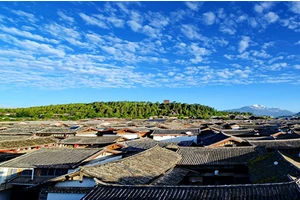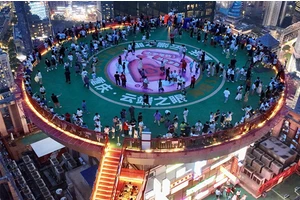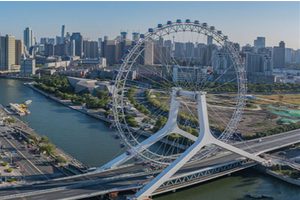The nearest tourist attraction to Xinzhou
Xinzhou City, located in the northeast of Shanxi Province, China, is a city with a long history and rich cultural heritage and natural scenery. The following are some recommended tourist attractions in Xinzhou:
Wutai Mountain: As one of the four famous Buddhist mountains in China, Wutai Mountain is famous for its long religious history, rich cultural heritage and beautiful natural scenery. There are many ancient temples, pagodas and temples here, among which the most famous ones include Bodhisattva Peak, Tayuan Temple and Luozi Mountain. Wutai Mountain is not only a pilgrimage site for Buddhist believers, but also an ideal place for tourists who like nature and history.
Yanmenguan: Yanmenguan is one of the famous passes in ancient China, located in Daixian County, Xinzhou City, and an important part of the Great Wall. There are not only the magnificent ruins of Guancheng, but also the spectacular ruins of the Great Wall. Yanmenguan, with a long history, was once an important channel for communication between ancient Han nationality and northern nomadic people.
Yungang Grottoes: Although Yungang Grottoes is located in Datong City, it is not far from Xinzhou City, and it is one of the four famous grottoes in China. There are 45 main grottoes and more than 51,000 Buddha statues here, which show the superb skills of ancient Buddhist art in China. The exquisite carving art of Yungang Grottoes is of great value to the study of ancient religion, sculpture, architecture and painting in China.
Ningwu Hangkong Village: Located in ningwu county, it is famous for its unique geographical location and architectural style. The house is built on a cliff, as if hanging in the air, giving people a thrilling feeling. The natural scenery here is also very charming, and it is an excellent place for photographers and explorers.
Hutuo River Scenic Area: Hutuo River is the mother river of Xinzhou City, with beautiful scenery along the coast and clear water. There are many scenic spots in the scenic area, such as Wannian Ice Cave and Cross-Gate Hanging Coffin, which are all worth visiting. In addition, you can also go boating, fishing and other water activities here.
Xinzhou Ancient City: Xinzhou Ancient City has preserved many buildings in the Ming and Qing Dynasties, and its walls, streets and houses all reveal a strong historical and cultural atmosphere. Here, visitors can stroll in the ancient city and feel the style of the ancient city.
Tianjishan National Forest Park: Located in Pianguan County, Xinzhou City, it is a comprehensive park integrating forest eco-tourism, popular science education, leisure and entertainment. With dense vegetation and fresh air, the park is a good place for urban residents to spend their summer vacation and relax.
Xinzhou Museum: To understand the history and culture of a place, local museums are always not to be missed. Xinzhou Museum has a large collection of historical relics and exhibits. Through these exhibits, visitors can learn more about Xinzhou's history and culture.
Pingxingguan Victory Memorial Hall: Pingxingguan Victory was an important battle in China War of Resistance against Japanese Aggression. The memorial hall lets visitors know the importance of this historical event through a large number of historical materials and physical displays.
Qicun Hot Springs: Located in Dingxiang County, Xinzhou City, the hot springs here have excellent water quality and contain many minerals beneficial to human body. Soaking in hot springs here can not only relax your body and mind, but also help your health.
In short, Xinzhou is a place full of historical charm and natural beauty. No matter tourists who are interested in history and culture or travelers who like natural scenery, they can find their own travel experience here.
Which scenic spot is Xinzhou Ancient City near?
Yuwangdong scenic spot.
Yuwangdong National Forest Park, one of the four major scenic spots, is located at the waist of Zhoushan, 19 kilometers away from Xinzhou Ancient City. According to legend, Dayu used to control water here, hence its name. Another said that there was a stone statue in the cave, which resembled Yu Wang and was later renamed Yuwang Cave. Yuwang Cave is a natural limestone cave. According to the Wanli annals of Xinzhou Ming Dynasty, this cave leads to Pingshan, Hebei Province. The road in the cave is connected with the road, and the hole is connected with the hole, which makes Xia Zhishi chill and blow gently, and it is as warm as spring in the dead of winter. At present, the proven caves are more than 7,000 meters deep, and there are three halls and ten caves open to the outside world, namely, flood discussion hall, flood control hall, flood discharge hall, Jingui Cave, Shenxian Cave, Crystal Cave, bottomless pit, Jiuqu Circulating Cave, Guanyin Cave, Feima Cave, Shihua Cave and Yixiantian Cave. There are countless stalagmites, stone flowers and stone buddhas in the cave, and there are many natural landscapes such as lions welcoming guests, Sean Chen in the mountain village, Crystal Palace, Huixian Bridge and Zhenhai Pagoda, which are very rare.
Top ten must-see attractions in Xinfu District?
1. Wutai Mountain
World Heritage 5A Scenic Area National Scenic Area National Forest Park National Geological Park
Wutai Mountain in Shanxi is the Dojo of Manjusri Bodhisattva. It is also known as the four famous Buddhist mountains with Mount Emei in Sichuan, Mount Putuo in Zhejiang and Mount Jiuhua in Anhui. It is known as "Golden Wutai, Emei in Silver, Putuo in Copper and Jiuhua in Iron". It ranks first among the four famous Buddhist mountains with its long history and culture and large-scale temple buildings. Wutai Mountain is a series of peaks located on the "Roof of North China", with the highest elevation of 3061 meters. It is also a Buddhist Dojo where green temples and yellow temples coexist. The constant Buddhist activities all the year round turn the scenic spot into a real Buddhist world. Every summer, pilgrims from home and abroad come to visit and burn incense and worship Buddha.
2. Wannian Ice Cave in Ningwu
4A Scenic Area National Geopark
Wannian Ice Cave is located in Chunjingqi Township, Dongzhai, 50 kilometers west of ningwu county City, Xinzhou City. This cave was formed in the Cenozoic Quaternary Glacier Period, about 3 million years ago, hence the name Wannian Ice Cave. The scenic spot is a national 4A-level tourist attraction and a national geological park. The ice cave in ten thousand years has accumulated a lot of information about the changes of atmosphere, climate, species and the birth and evolution of human beings. As the information precipitation of the earth's history, it has never been modified by man-made destruction, so it has great scientific value and ornamental value.
3. Yanmenguan Scenic Area
5A scenic spot
Yanmenguan is an important part of Wan Li Great Wall, a world cultural heritage, and a national key cultural relic protection unit. It is an ancient pass with a long history, frequent wars, high popularity and wide influence, and is known as "the first pass in China". Yanmenguan Scenic Area is a frontier fortress culture, Great Wall culture and pass culture tourist area with the historical remains and sites of Yanmenguan military defense system as the main landscape resources. The planned area of the scenic area is 30 square kilometers, and it is a frontier fortress cultural tourist destination integrating the comprehensive functions of "eating, living, traveling, traveling, shopping and entertainment".
Six scenic spots that Xinzhou must visit?
1. Wutai Mountain
Located in Wutai County, Xinzhou City, surrounded by five peaks with platforms, it is a famous summer resort with beautiful scenery. In addition, it is also the Dojo of Manjusri Bodhisattva, with many temples, ranking first among the four famous Buddhist mountains in China. This is the Dojo where the Yellow Temple (Tibetan) and the Qing Temple (Han Chuan) coexist. You can see not only the monks of Han Chuan, but also Tibetan lamas.
2. Yanmenguan
Located 30 kilometers northwest of Daixian County, Xinzhou, it is the pass on the Great Wall Line in the Ming Dynasty, and together with Ning Wuguan and Pianguan, it is called the "outer three passes." There is no public transportation from Daixian county to the scenic spot, so you can only go by chartered bus, and playing in the scenic spot is also entirely on foot. Yanmenguan has been an important pass for the Central Plains Dynasty to resist the invasion of northern nomads since ancient times. The earliest history here can be traced back to the Warring States period when King Wuling of Zhao fought against Xiongnu. Li Guang, Wei Qing and Huo Qubing, famous soldiers of the Han Dynasty, once led troops to fight with Xiongnu. In the Northern Song Dynasty, Yanmenguan became the main battlefield of confrontation between Song Dynasty and Liao Dynasty. The well-known prototype of Yang Jiajiang's story happened here, and there was a statue of Yang Liulang in the scenic spot.
3. Wannian Ice Cave
Formed in the Cenozoic Quaternary Glacier Period, about 3 million years ago, hence the name Wannian Ice Cave. This ice cave ranks first among only nine of the more than 10,000 caves in China. The cave has the strongest refrigeration mechanism and the largest ice reserves, and it is now developed for nearly 100 meters. The developed part is divided into three layers, including ice curtain, ice clock, ice flower, ice man, ice Buddha and so on. There is ice on the inner wall of the cave, which is called an ice world. The scenery in the cave, large and small, is exquisite, dazzling, graceful and magnificent, all of which are amazing.
4. Xinzhou Ancient City
Located on the way from Taiyuan to Wutai Mountain, it is the resident of Xinzhou Administrative Office and prefectural committee. In the Spring and Autumn Period, Xinzhou belonged to the State of Jin, Zhao in the Warring States Period, Taiyuan County, Yanmen County and Taiping County in the Qin and Han Dynasties. Sui Dynasty was a new capital and Yanmen. The cultural relics in Xinzhou City are: the North Gate of Xinzhou City. Located in Xinzhou city, on the arch door of the old north city wall. The North Gate House was founded in the 24th year of Wanli in Ming Dynasty. The building is located on the 12-meter-high wall, which makes it even more majestic. Magnificent. The city wall stands tall, covered with scarlet, and a doorway is built under it, with a very high ceiling. The bottom is more than 3 meters wide.






